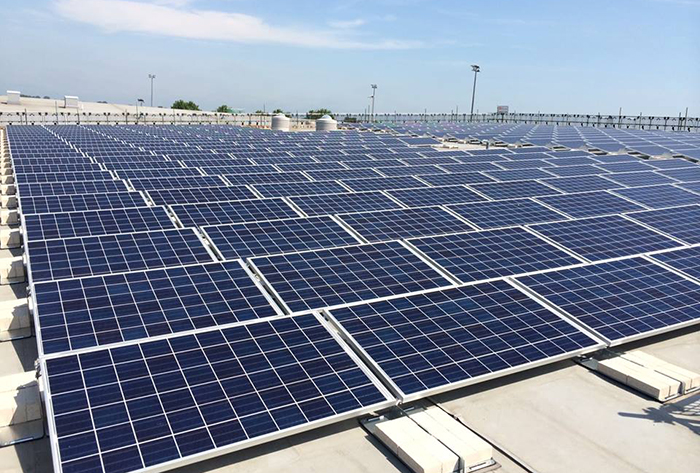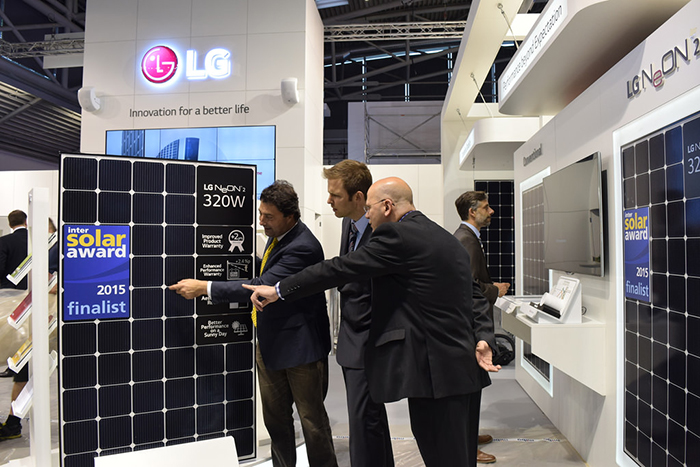Korea is now turning into a producer of eco-friendly solar energy, as more and more leading companies across the nation are expanding their investment in this renewable energy.
The Korean government released its "2030 Strategy for the Spread of New Energy Industries" in November 2014, in which it aimed at reducing greenhouse gas emissions of about 850.6 million tons by 37 percent by 2030. With this goal, the government vowed to create new markets for the production and trading of new energy sources, and to revitalize markets in terms of energy storage systems (ESS).
Joining in on the government-led effort, some of the nation’s major enterprises are now focusing more money on developing new renewable energy sources. Solar energy is, by far, the most noteworthy of these.

Last year, Hanwha Q Cells, a solar cell provider, built a new 1.5-gigawatt (GW) solar cell facility in Jincheon-gun County and a 500-megawatt (MW) solar module assembly plant in Eumseong-gun County, both in Chungcheongbuk-do Province. With these plants, the solar cell manufacturer is now pursuing the goal of expanding its capacity for solar cells up to 5.2GW by the first quarter of the year. Its current capacity for solar cell production, at around 3.7GW, comes from businesses in China and Malaysia.
Hanwha Q Cells also has plans to get into the solar power generation businesses in India and Turkey, too. It has agreed with the Indian government to supply 70MW solar modules by setting up a 148.8MW solar power plant. In Turkey, it has set up 18.3MW plants, generating around 13.457 megawatt hours (MWh) of clean energy per year, enough to power around 2,700 households across the nation.

OCI, a green energy and chemicals company, is zeroing in on the green energy industry, too. The company has set itself the goal of making more than 20 percent of its net profits from energy projects, including solar energy, by 2020. As part of these efforts, it turned a 270,000-square-meter crab farm into a 10MW solar power plant in Hongze County, Jiangsu Province, China, completing the work on Jan. 27. The energy provider plans to also complete the construction of more 400MW solar power plants by the end of year in San Antonio, Texas.

LG Electronics has announced that it would invest KRW 527.2 billion in solar energy businesses over the next three years. The conglomerate will bring the number of solar module production lines up to 14, with the addition of six more production plants in Gumi, Gyeongsangbuk-do Province. The company aims to ramp up its yearly production capacity to 3GW by 2020, up from the current 1GW capacity. In November last year, the firm also unveiled a new photovoltaic module product, NeON2, which boasts a greater efficiency rate of 19.5 percent.
Finally, Samsung SDI has been actively involved in new green energy developments, expecting them to be next-generation growth engines. Investing about KRW 3 trillion in the development of advanced energy storage systems by 2020, the company plans to further expand its green energy movement.
By Sohn JiAe
Korea.net Staff Writer
Photos: Hanwha Q Cells, OCI, LG
jiae5853@korea.kr
The Korean government released its "2030 Strategy for the Spread of New Energy Industries" in November 2014, in which it aimed at reducing greenhouse gas emissions of about 850.6 million tons by 37 percent by 2030. With this goal, the government vowed to create new markets for the production and trading of new energy sources, and to revitalize markets in terms of energy storage systems (ESS).
Joining in on the government-led effort, some of the nation’s major enterprises are now focusing more money on developing new renewable energy sources. Solar energy is, by far, the most noteworthy of these.

Hanwha Q Cells plans to increase its investment in solar energy, both at home and abroad.
Last year, Hanwha Q Cells, a solar cell provider, built a new 1.5-gigawatt (GW) solar cell facility in Jincheon-gun County and a 500-megawatt (MW) solar module assembly plant in Eumseong-gun County, both in Chungcheongbuk-do Province. With these plants, the solar cell manufacturer is now pursuing the goal of expanding its capacity for solar cells up to 5.2GW by the first quarter of the year. Its current capacity for solar cell production, at around 3.7GW, comes from businesses in China and Malaysia.
Hanwha Q Cells also has plans to get into the solar power generation businesses in India and Turkey, too. It has agreed with the Indian government to supply 70MW solar modules by setting up a 148.8MW solar power plant. In Turkey, it has set up 18.3MW plants, generating around 13.457 megawatt hours (MWh) of clean energy per year, enough to power around 2,700 households across the nation.

OCI supplies enough energy to power about 3,600 households, as it operates solar power plants in Hongze County, Jiangsu Province, China.
OCI, a green energy and chemicals company, is zeroing in on the green energy industry, too. The company has set itself the goal of making more than 20 percent of its net profits from energy projects, including solar energy, by 2020. As part of these efforts, it turned a 270,000-square-meter crab farm into a 10MW solar power plant in Hongze County, Jiangsu Province, China, completing the work on Jan. 27. The energy provider plans to also complete the construction of more 400MW solar power plants by the end of year in San Antonio, Texas.

LG Electronics releases its new photovoltaic module product, NeON2, at the Intersolar Award 2015 in Germany last year.
LG Electronics has announced that it would invest KRW 527.2 billion in solar energy businesses over the next three years. The conglomerate will bring the number of solar module production lines up to 14, with the addition of six more production plants in Gumi, Gyeongsangbuk-do Province. The company aims to ramp up its yearly production capacity to 3GW by 2020, up from the current 1GW capacity. In November last year, the firm also unveiled a new photovoltaic module product, NeON2, which boasts a greater efficiency rate of 19.5 percent.
Finally, Samsung SDI has been actively involved in new green energy developments, expecting them to be next-generation growth engines. Investing about KRW 3 trillion in the development of advanced energy storage systems by 2020, the company plans to further expand its green energy movement.
By Sohn JiAe
Korea.net Staff Writer
Photos: Hanwha Q Cells, OCI, LG
jiae5853@korea.kr
Most popular
- Grammy-winning producer calls Suga of BTS 'amazing artist'
- Animated 'KPop Demon Hunters' tops Netflix charts in 41 markets
- 'Squid Game' events to pump up K-Content Seoul Travel Week
- Reunited BLACKPINK releases video preview of world tour
- 'Universal love, family' themes fuel success of 'King of Kings': director
